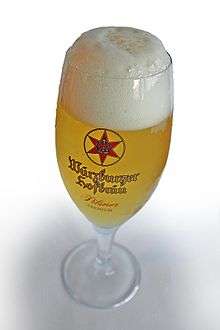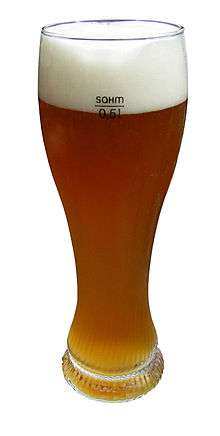Beer head

Beer head (also head or collar),[1] is the frothy foam on top of beer which is produced by bubbles of gas, typically carbon dioxide, rising to the surface. The elements that produce the head are wort protein, yeast and hop residue. The carbon dioxide that forms the bubbles in the head is produced during fermentation. The carbonation can occur before or after bottling the beer. If the beer continues fermenting in the bottle, then it naturally carbonates and the head is formed upon opening and/or pouring the beer. If the beer is pasteurized or filtered then the beer must be force carbonated using pressurized gas.
The density and longevity of the head will be determined by the type of malt and adjunct from which the beer was fermented. Different mash schedules and cereal sources influence head retention. In general, wheat tends to produce larger and longer-lasting heads than barley.
Importance
Consumers tend to place a lot of importance on beer heads: too much of a head is undesirable because it detracts from the mass of the drink (similar to carbonated soda drinks), on the other hand a poured beer is viewed as incomplete unless it has the specific form of head expected for the type of beer. Some view the head on a beer as important because it helps provide the aroma of the beer. Another opinion is that it is important for the aesthetic look of the beer. The commercial significance of the head has led to academic studies.[2]
At least one study suggests that the head assists in transport of beer after pouring by damping oscillation (sloshing) and converting vertical movement into horizontal movement. [3]
Formation through carbon dioxide
The carbon dioxide may be produced naturally through the activity of brewers yeast, or artificially by dissolving carbon dioxide under pressure into the liquid. The beer head is created by the carbon dioxide produced as a byproduct of the metabolism of brewer's yeast acting upon starches and sugars found in the wort.
Chemical composition
While the actual foam activity of beer depends on the presence of carbon dioxide, it is the surface-active materials like amphipathic polypeptides from malt that determine size, shape and length of the foam.
Beer foam consists of polypeptides of five different classifications, divided by their relative hydrophobicity. As the hydrophobicity of the polypeptide groups increases, so does the stability of the foam.[4]
Carbonation occurs when carbon dioxide is dissolved in water or an aqueous solution. This process is generally represented by the following reaction, where water and gaseous carbon dioxide react to form a dilute solution of carbonic acid.
Importance of the glass

Beer glassware is often designed to accentuate or accommodate the head. Many other properties of the glass can also influence a beer head,[5] such as a roughened surface at the base of glass known as a widget, providing for nucleation of carbon dioxide deep in the beverage rather than at the surface, resulting in a slower release of gas to the atmosphere.
Glass surfaces can retain oil from the skin, aerosolized oil from nearby cooking, and traces of fat from food. When these oils come in contact with beer there is a significant reduction in the amount of head (foam)[6][7] that is found on the beer, and the bubbles will tend to stick to the side of the glass rather than rising to the surface as normal.
For proper foam formation, it is also important to dry the glass thoroughly after washing. Any water in the glass can prevent excitement of the gas by covering designs set in the bottom of the glass, thus making the beer flat. Conversely, some styles such as Belgian witbier benefit from being poured into a wet glass to control the often abundant head.
Formation of 'nitrogen head'
The creamy head on beers such as Guinness is created by a widget in cans or bottles using nitrogen, or by the process of drawing keg beer from a keg using nitrogen or mixed gas (carbon dioxide and nitrogen). The use of nitrogen, which was pioneered by Guinness, creates a firm head with small bubbles while reducing the excessively acidic taste often produced by using carbon dioxide alone.
References
- ↑ Gregg Smith and Carrie Getty, The Beer Drinker's Bible (Boulder CO, 1997).
- ↑ German, J. B.; McCarthy, M. J. (1989). "Stability of aqueous foams: Analysis using magnetic resonance imaging". Journal of Agricultural and Food Chemistry. 37 (5): 1321. doi:10.1021/jf00089a025.
- ↑ (http://meetings.aps.org/link/BAPS.2014.DFD.H16.9)
- ↑ http://www3.interscience.wiley.com/journal/113320605/abstract
- ↑ "Glass To Last". Hospitalitymagazine.com.au. 2010-02-18. Archived from the original on 2010-03-06. Retrieved 2010-02-24.
- ↑ "Food Physics". www.physics.org. Retrieved 23 October 2013.
- ↑ "Physics, lipstick, beer". APS. Retrieved 23 October 2013.
External links
- There is plenty of physics involved in opening a bottle of beer - Richard Kingsley
- One beer please - Vivienne Baillie Gerritsen
- Cheers Physics! - physics.org